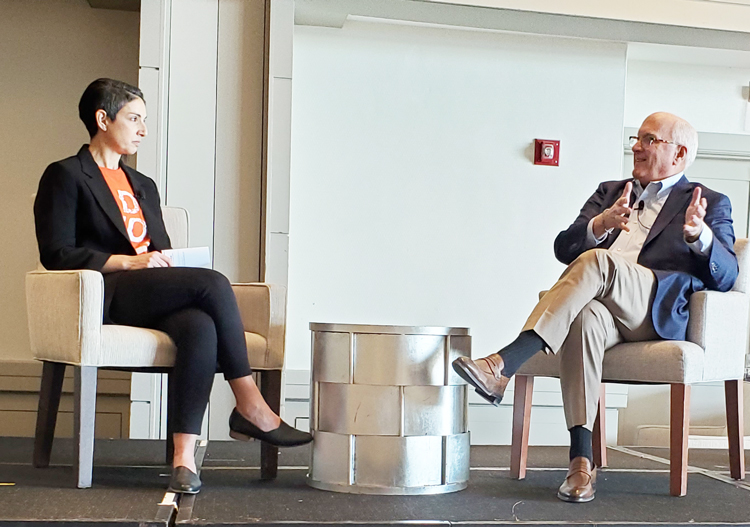The dearth of new supply in the seniors housing space is a double-edged sword, says Tom Grape, founder, chairman and CEO of regional operator Benchmark Senior Living. While the lack of new product has provided a much-needed lift to operators of existing communities seeking to boost occupancy, it’s also a missed opportunity for developers chomping at the bit to start new projects.
The year-over-year (YOY) inventory growth in seniors housing was 1.3 percent in the third quarter, nearly the smallest YOY growth since 2012, according to NIC MAP. Grape foresees the possibility of even slower inventory growth in the near term.
“We’ve got a development pipeline, but we’re sort of parking it. Construction costs remain high. We’re starting to see early signs that maybe those are softening a bit, but nothing has really softened materially,” said Grape during the keynote interview at the seventh annual InterFace Seniors Housing Northeast conference in Philadelphia on Wednesday, Nov. 29.
Laura Cambria of KARE, senior vice president of operations at KARE, a senior living staffing app that connects caregivers with operators, conducted the interview. France Media’s InterFace Conferece Group and Seniors Housing Business hosted the conference at the Hilton Philadelphia at Penn’s Landing. The daylong event included multiple panel sessions on a range of topics, including architecture, technology, finance and investment, development and operations.
The run-up in interest rates in 2022 and throughout much of 2023 before the modest contraction late this fall has made the borrowing climate extremely challenging for developers, emphasized Grape. “It’s really very difficult to make deals pencil out, and/or to get the capital for new developments. So, we’ve got a number of sites that we’re just sort of parking and trying to hang on to for times when they make sense to develop.”
The cost to acquire assets is lower than the cost to develop today, emphasizes Grape. That’s particularly true for distressed assets plagued by a slow recovery in occupancy and rent growth post-pandemic while incurring higher operating costs in an inflationary environment, according to Grape. “We’re at the stage of the cycle where development doesn’t make as much sense as acquiring [properties] in a lot of cases today.”

Benchmark’s occupancy rebounds
Grape said he couldn’t think of a single construction start this year for a seniors housing project in the Northeast region in which Benchmark operates. “The projects that I know of under construction really began before interest rates ran up. We’ve got a couple of projects that will deliver in 2024, but they began before rates really spiked.”
Benchmark at Alexandria in Alexandria, Virginia, and Benchmark at Mount Pleasant in Mount Pleasant, New York are scheduled to open in 2024.
The good news is occupancy has rebounded across Benchmark’s portfolio. “Everybody has been trying to recover occupancy since the pandemic, and we’re certainly no different. We’ve been fortunate to get our occupancy back to 90 percent,” said Grape. Benchmark’s occupancy figure exceeds the third-quarter industrywide average of 84.4 percent, according to NIC MAP.
Headquartered in Waltham, Massachusetts, Benchmark operates 64 properties totaling 7,084 units as of June 1, ranking it as the 26th largest operator of U.S. seniors housing, according to the American Seniors Housing Association (ASHA).
The company, which offers independent living, assisted living, memory care and continuing care retirement communities, operates in seven Northeastern states. Grape founded the company in 1997.
Turning point for operators?
YOY rent growth in the assisted living sector in the first quarter of this year was 6.3 percent versus 6.1 percent for wage growth, according to NIC MAP. That marked the first time since the fourth quarter of 2016 whereby YOY rent growth in assisted living surpassed wage growth. Similarly, in the second quarter, YOY rent growth was 6.6 percent versus 6 percent for wage growth.
It’s an important inflection point because wages have climbed as much as 30 percent over the last two to three years in some regions of the country, noted Grape. “While we’ve all been able to increase rates pretty meaningfully, it hasn’t been at that same level,” said Grape.
The cumulative effect of higher wages and operating costs over the past three years has cut into profit margins, explained Grape. The heavy reliance on healthcare staffing agencies during and even after the pandemic for an extended period of time caused operational costs to balloon. Benchmark has reduced its use of agency staffing by hiring more employees, thereby trimming expenses.
Adding insult to injury, the industry experienced significant increases in utility costs, which have started to recede, said Grape. The same can’t be said of property insurance premiums, which remain at elevated levels.
The fact that wage growth, the biggest expense, is starting to slow is providing some much-needed relief for the senior living industry, said Grape. “We can’t continue to increase [rents] at the same pace that we have been indefinitely. That will obviously increase the affordability issue that’s talked about in our industry. We’re chipping away at every nickel and dime on the P&L statement that we possibly can, and we’re making some progress.”

The recruiting challenge
Upwards of 80 percent of senior living operators nationally are still grappling with worker shortages, according to the latest industry surveys. As the largest seniors housing company in the Northeast with a workforce of approximately 6,300 associates, Benchmark relies on a “menu” of recruiting tools, and those tools can vary somewhat from one market to another.
“There are some markets where we can’t find a nurse to save our lives. There are some markets where we can’t find servers. Obviously, we do wage studies from market to market and increase wages where we need to as appropriate,” said Grape.
Benchmark has increased its recruiting staff and extended its outreach through job fairs, social media and employment websites such as Indeed. The company has also cultivated relationships with local schools and colleges.
While some tools are more effective than others when trying to fill certain positions, compensation is the starting point, said Grape. And once the employee is hired, the onboarding, training and mentoring process is vitally important to help minimize turnover. Keeping the lines of communication open with former Benchmark alumni also has proven to pay dividends.
“We’ve had a huge number of folks return to Benchmark who may have left for various reasons. We’ve had hundreds of people each year return to Benchmark who thought that the grass might be greener somewhere else, and they find that it isn’t.”
For her part, Cambria said that it’s vitally important for senior living operators to listen to caregivers and be responsive to their needs — or suffer the consequences.
“We’re seeing people leave the industry because there is more flexibility in other areas. Yet, our CNAs specifically want to be working in senior living. There’s a reason they’re choosing to. And we know our CNA population often has two to three jobs. They’re working several positions,” said Cambria.
On the hiring front, it used to be that Benchmark only had to be concerned about what its peer competitors were paying prospective employees, explained Grape. But that era has passed.
“We’re now having to worry about being an employer of choice versus Walmart and Dunkin’ Donuts, you name it. We’re now competing with all employers, not just other senior living employers. That’s really been a marked change. So, our wage studies are not just relative to our peer competitors, but relative to sort of all employers in the market. That’s a whole different kettle of fish,” said the veteran senior living executive.
Healthy consumer demand bodes well
In the third quarter, net absorption totaled 7,853 units in the 31 primary markets tracked by NIC MAP. That was nearly three times the roughly 2,800 new units that came online during the same time period.
By comparison, the average quarterly net absorption in 2019, the year before the onset of the pandemic in the U.S, was approximately 3,600 units.
The number of occupied units in these primary markets hit another record high in the third quarter, rising to nearly 591,000 units. Occupied units in the secondary markets also hit an all-time high of nearly 323,000 units.
Grape told the InterFace conference attendees that the robust level of absorption post-pandemic demonstrates a vote of confidence in the industry. “The notion that people wouldn’t move into a congregate setting again for fear of infections and so on has been refuted. And in fact, it’s quite the opposite. Our experience was that people [who lived through] the pandemic realize the risks and downside of isolation and the like.”
The bottom line is prospective residents and their families value the importance of socialization, said Grape. “I’ve got to think that’s the most positive thing that has come out of the last couple of years.”
— Matt Valley

